#linear equations in one variable class 8 important questions
Explore tagged Tumblr posts
Text
Class 9 math final preaparion for annual examination
Class 9 math final preaparion for annual examination
Class 9 Math Final Exam Crash Course,Last-Minute Class 9 Math Exam Tips and Tricks,Quick Revision Guide for Class 9 Math Exam,Class 9 Math Syllabus Summary for Finals,Top 10 Tips for Scoring High in Class 9 Math, Final Hour Class 9 Math Exam Preparation,Class 9 Math Most Important Topics for Exam,Essential Class 9 Math Formulas for Finals,Class 9 Math Problem Solving Techniques for Exams,Class 9 Math Exam Day Preparation Checklist,Class 9 Math Final Preparation Tips,Last Minute Math Revision for Class 9,Class 9 Math Quick Revision Guide,Class 9 Math Exam Success Tips,Effective Study Plan for Class 9 Math Final,Math Exam Boosters for Class 9,Class 9 Math Formula Cheat Sheet,Quick Math Review for Class 9 Finals,Class 9 Math Last-Minute Practice, Class 9 Math Preparation Strategies Mathematics Time: 3 hours Full Marks: 100 Section A: Objective (25 Marks) Multiple Choice Questions: Write the correct answer in your answer sheet 1 × 15 = 15 1. Fibonacci was ---- (a) Mathematician (b) Statistician (c) Physicist (d) Chemist 2. What is the sum of n natural numbers? (a) (b) (c) (d) 3. If the general term of a sequence is , what is the second term? (a) (b) (c) (d) 4. The base of an exponent and the base of log are ----- i The same ii Equal iii Different Which of the following is correct? (a) i and ii (b) ii and iii (c) i and iii (d) i ii and iii 5. Under what condition is always positive for all values of n? (a) b > 0 (b) b (c) b = 0 (d) b ≠ 1 6. = Which of the following? (a) (b) (c) (d) 7. Which of the following points is located on the x-axis? (a) (2, 0) (b) (-3, 5) (c) (0, 3) (d) (-2, -2) 8. How many primary methods are there for solving linear equations with two variables? (a) 2 (b) 3 (c) 4 (d) 5 Based on the following information, answer questions 9 and 10:
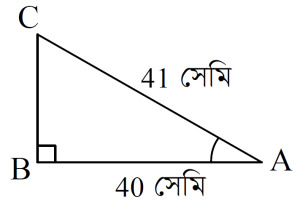
9. What is the length of BC? (a) 9 cm (b) 29 cm (c) 39 cm (d) 49 cm Class nine math for annual exam part 1 10. What is the value of sin ∠BAC? (a) (b) (c) (d) 11. If a right-angled triangle is formed with sides of 17 cm, 8 cm, and 15 cm, what will be the length of the hypotenuse? (a) 8 (b) 13 (c) 17 (d) 23 12. Which of the following distances do the hands of a wall clock traverse? (a) Linear distance (b) Perpendicular distance (c) Angular distance (d) Parallel distance 13. Dividing a complete rotation by 360 results in what kind of angular distance? (a) 1' (minute) (b) 10° (degree) (c) 1'' (second) (d) 1c (radian) 14. Mushfiq's runs in 10 matches are: 56, 30, 26, 37, 78, 65, 28, 48, 54, 16. What is the median of his runs? (a) 72.5 (b) 42.5 (c) 70 (d) 77.5 15. Last year's minimum temperature was 11°C, and the temperature range was 33°C. What was the maximum temperature last year? (a) 42°C (b) 32°C (c) 35°C (d) 44°C Answer in one word: 1 × 10 = 10 16. If the n-th term, = 1, what type of sequence is it? 17. What is the tenth term of the sequence 0, 1, 1, 2, 3, 5, ......? 18. Write the formula for . 19. In , what is the condition for a = b? 20. In a graph, what does each line of a linear equation represent? 21. In a right-angled triangle, the base and height are named with respect to what? 22. Which type of angle has an undefined measure? 23. In the standard position, what is the value of tan ( theta ) relative to the point (15, 0)? 24. What is the term for the difference between the central value and other data points? 25. How is the range of measurement represented? Section B: Short and Descriptive (75 Marks) 1. Answer the following questions: 2 × 13 = 26 (a) In an arithmetic sequence, if the fifth term is 16 and the ninth term is 28, find the first term and common difference. (b) For a sequence with the sum of the first n terms as n(n + 1), what is the sum of the first 10 terms? (c) Find the general term of the sequence , ... (d) If , find the value of ( x ). (e) Show that an earthquake measuring 8 on the Richter scale is 1000 times stronger than one measuring 5. (f) Verify the solvability of the equations x + y = p + q and . (g) Determine the nature of the roots of the equation and solve it. (g) is a right-angled triangle with , cm, cm, and . Find the value of . (h) What is the value of ? (i) Express in radians. (j) Express the point in terms of . (k) Find the range of the data set . (l) If the arithmetic mean of the data series is , find the mean deviation. 2. Observe the following sequences: (i) 1 − 3 + 9 − 27 + ..... and (ii) 54 + 18 + 6 + ... + (a) Find the sum of the first 7 terms of sequence (i). 3 (b) Find the sum of sequence (ii). 4 3. Anika and Mim are two sisters. Their parents decide to give them pocket money for 10 days using two different methods. On the first day, both Anika and Mim receive 2 taka each. Anika receives double the previous day’s amount each day, while Mim receives 2 taka more than the previous day. (a) Determine who receives more pocket money on the fifth day, Anika or Mim. 3 (b) Verify whether Anika receives 18 times more total pocket money than Mim over the first 10 days. 4 4. and (a) If , find the value of . 3 (b) If , what is the value of ? 4 5. The intensity of sound emitted from a motorcycle is W per square meter. An autorickshaw emits 60 decibels of sound, and a rickshaw emits 50 decibels of sound. (a) How many decibels of sound are emitted from the motorcycle? 2 (b) What is the intensity of sound emitted per square meter from the autorickshaw? 2 (c) Compare the sound intensity between the autorickshaw and the rickshaw. 3 6. Kona bought 5 guava saplings and 4 lemon saplings for 410 taka at a tree fair. Raju bought 4 guava saplings and 5 lemon saplings at the same rate for 400 taka. The price of each lemon sapling is 10 taka less than each guava sapling. (a) Form a system of equations based on the given information. 1 (b) Solve the system of equations obtained in (a) using the cross-multiplication method. 3 (c) Solve the system of equations obtained in (a) using the elimination method. 3 7. A fruit seller bought mangoes at 20 taka each and bananas at 10 taka each, spending a total of 1000 taka. He sold each mango and banana at a profit of 2 taka, making a total profit of 120 taka. (a) Form two equations based on the information provided. 3 (b) How many mangoes and bananas did the fruit seller buy? 4 8. A student was standing at point P in front of a tower. The angle of elevation to the top of the tower from point P is 30°. Moving 50 meters closer to the tower to point Q, the angle of elevation becomes 45°. (a) Represent the information with a diagram. 3 (b) Find the height of the tower. 4 9. Noyon went on a trip with his family from Dhaka to Cox’s Bazar in their own car. The radius of their car’s wheels is 0.6 meters, and the radius of the Earth is 6440 km. (a) If Dhaka and Cox’s Bazar subtend an angle of 20° at the Earth’s center, find the distance between them. 3 (b) How many rotations will the car's wheels make to cover the total distance from Dhaka to Cox’s Bazar? 4 10. Shakib’s runs in eight matches are as follows: 72, 55, 100, 67, 82, 40, 76, 80 (a) Calculate Shakib’s average runs. 2 (b) Show that Shakib’s median runs are higher than his average runs. 2 (c) Find the mean deviation from the median. 11. The run data of two batsmen over 6 matches is as follows: Tamim's runs 45 75 100 25 65 55 Soumya's runs 102 20 85 35 10 35 (a) Calculate the range of runs for both batsmen. 2 (b) Find the mean, median, and mode of Tamim's runs. 2 (c) Calculate the mean deviation from the mean, median, and mode for Tamim's runs. 3 Read the full article
#Class9MathExamDayPreparationChecklist#Class9MathExamSuccessTips#Class9MathFinalExamCrashCourse#Class9MathFinalPreparationTips#Class9MathFormulaCheatSheet#Class9MathLast-MinutePractice#Class9MathMostImportantTopicsforExam#Class9MathPreparationStrategies#Class9MathProblemSolvingTechniquesforExams#Class9MathQuickRevisionGuide#Class9MathSyllabusSummaryforFinals#EffectiveStudyPlanforClass9MathFinal#EssentialClass9MathFormulasforFinals#FinalHourClass9MathExamPreparation#LastMinuteMathRevisionforClass9#Last-MinuteClass9MathExamTipsandTricks#MathExamBoostersforClass9#QuickMathReviewforClass9Finals#QuickRevisionGuideforClass9MathExam#Top10TipsforScoringHighinClass9Math
0 notes
Link
CBSE Class 10 Syllabus has been designed to help students gain a deeper understanding of the subject matter.
0 notes
Text
Class-8 Mathematics NCERT Solution Execrise 2.4 Question 3,4,5
#linear equations in one variable class 8 in hindi#linear equations in one variable class 8 ex 2.1#linear equations in one variable class 8 in english#linear equations in one variable class 8 activity#linear equations in one variable class 8 answers#linear equations in one variable class 8 all formulas#linear equations in one variable class 8 cbse#linear equations in one variable class 8 chapter 2#linear equations in one variable class 8 dav#linear equations in one variable class 8 full chapter#linear equations in one variable class 8 formulas#linear equations in one variable for class 8#linear equations in one variable class 8 hindi#linear equations in one variable class 8 hindi medium#linear equations in one variable class 8 important questions#Math's with Narendra Sir provide to you maths videos for all classes.#Maths with Narendra Sir give you live-class platform#for math skills.#Learn math by taking free online math courses.#Get introductions to algebra#geometry#trigonometry with current math coursework and AP exam preparation.#Select a course to learn more.#We create a unique adaptive learning path for you#We diagnose and identify the student’s current needs#We recommend topics that are right for the student#Students choose and work through the topics at their own pace#We supplement the in-class learning with targeted at-home practiceMath's with Narendra Sir provide to you maths videos for all classes.#Select a course to learn more. basic mathema#tics
0 notes
Text
NCERT Solutions for Class 10 Maths
NCERT Solutions for Class 10 maths covers all exercise questions given in the CBSE textbook. You can download this as free pdf from this page. Our best Mathematics master teachers have reviewed all the class 10 maths ncert solutions of exercise questions that will help you solve all the NCERT class 10 maths questions without any problem. We at Learncbse provide free PDF solutions for NCERT maths class 10 for your ease. You can also share the link of our Learncbse website with your classmates so that they can also download CBSE class 10th math NCERT solution. At any point of time, if you have any doubt while going through the class 10 maths NCERT solutions, The online classes will be conducted by one of our best mathematics teachers. You can even talk to the tutor as you would in a normal tuition class.
https://www.quora.com/What-are-the-chapters-contained-in-the-NCERT-solutions-for-class-10-maths https://www.quora.com/profile/Arika-Ahuja https://www.quora.com/unanswered/What-are-the-chapters-contained-in-the-NCERT-solutions-for-class-10-maths
NCERT Solutions for Class 10 Maths - Free PDF Download Class 10 being a whole new experience for you as it will be the very first time when you will be appearing for the board exams. Speaking of which, a thorough knowledge of all the chapters along with NCERT Solutions for Class 10 Maths can really help you to understand the subject better in less time. Below given are the chapters and the topics and exercises entailed in each of them. Scroll down to get well-versed with each and every chapter of CBSE Class 10 Maths.
Chapter 1 – Real Numbers
NCERT Class 10 Math Chapter 1, Real Numbers, is the extension of the topics learnt in 9th class. Sections 1.2 and 1.3 of this chapter contains some very important properties of positive integers, namely Euclid’s division algorithm and the Fundamental Theorem of Arithmetic. Furthermore, you will be revisiting Irrational Numbers in section 1.4 whereas Revisiting Rational Numbers and Their Decimal Expansions will be included in Section 1.5. Euclid’s division algorithm has a lot to do with divisibility of integers. It has plethora of applications associated with the divisibility properties of integers. NCERT Class 10 Maths Chapter 1, Real Numbers will be highly beneficial to compute the HCF of two positive integers.
Chapter 2 - Polynomials
Polynomials has total of four exercises however the last exercise is optional. In the first exercise, you need to find zeroes of polynomials p(x). In the second exercise, there are two questions. You have to verify the relationship between the zeroes and the coefficients in the first, while in the second, you have to find a quadratic polynomial. The third exercise has a total of five questions in which you have to do division of polynomials and obtain zeroes of polynomials. Then comes the optional exercise which has five questions in which you need to find zeroes of polynomials.
Chapter 3 - Pair of Linear Equations in Two Variables
There is an introduction part in the beginning of this chapter explaining the concepts of Linear equations in two Variables. You will learn some further complex topics while revising concepts that you have learned in class 9. This chapter has a total of seven exercises in which the last exercise is optional again. You will see three world problems given in the first exercise. In the second exercise, there are a total of seven questions. The third exercise has three questions. The fourth exercise has two questions. The fifth exercise has a total of` five questions in which you have to solve the pair of linear equations through various methods given. The sixth exercise has two questions. The last exercise is optional. Some important topics covered in this chapter are graphical representations, Pair of Linear Equations in Two Variables, Algebraic Methods of Solving a Pair of Linear Equations, Graphical Method of Solution of a Pair of Linear Equations, Elimination Method, Substitution Method, Cross-Multiplication Method and Equations Reducible to a Pair of Linear Equations in Two Variables.
Chapter 4 - Quadratic Equations
You will study quadratic equations and number of ways to find their roots. You will also get to learn some applications of quadratic equations in our daily life situations. There is a total of four exercises in this chapter. The first exercise has two questions, in the first you will need to find check whether equations are quadratic equations or not while in the second you have to convert world problem into quadratic equations. You need to find the roots of quadratic equations by factorisation in the second exercise. You will be finding the roots of quadratic equations in the third exercise also. The fourth exercise has five questions based on finding the roots. Solution of a Quadratic Equation by Completing the Square, Solution of a Quadratic Equation by Factorisation, and Nature of Roots are the main topics studied in this chapter.
Chapter 5 - Arithmetic Progressions
Arithmetic Progressions, chapter 5 of Class 10 Maths, deals with an introduction to Arithmetic Progression with the help of simple daily life examples and gradually deals with the topics entailed and their complexities. Four exercises are given in this chapter divided into various questions in which we have to find the term. Overall, you will learn how to find the nth terms and the sum of n consecutive terms, and in turn use the acquired knowledge in solving some daily life problems.
Chapter 6 - Triangles
There are six exercises in chapter 6, Triangles, including one optional having different set of questions based on the properties of triangles. This chapter has a total of 9 theorems and is very important for all the students of class 10 Maths for their class 10 Board exam.
https://sites.google.com/site/mathsncertsolutionshttps://sites.google.com/site/ncertsolutionsblog/ncert-solutions-for-class-10
https://sites.google.com/site/ncertsolutionsblog/ncert-solutions-for-class-10-maths http://www.learncbse.in/ncert-class-10-math-solutions/ https://sites.google.com/site/slstudycentre/home/kendriya-vidyalaya
Chapter 7 - Coordinate Geometry
A total of four exercises are given in the chapter. The questions are based on finding the distance between the two points whose coordinates are provided and area of a triangle formed by three given points.
Chapter 8 - Introduction to Trigonometry
This chapter has a total of four exercises comprising of various questions mainly on finding trigonometric ratios of the sides of a right triangle with respect to the acute angles of that triangle, called trigonometric ratios. Trigonometric Ratios, Trigonometric Ratios of Specific Angles, Trigonometric Identities and Trigonometric Ratios of Complementary Angles are the main topics you will learn in this chapter.
Chapter 9 - Some Applications of Trigonometry
In this chapter, you will be studying about some very interesting ways in which trigonometry is uded in the daily life around you. This chapter has only one exercise and the questions of which are based on the practical applications of trigonometry.
Chapter 10 - Circles
Circles has just two exercises. The first exercise contains basic questions, while the second has various questions in which you have to prove the given equations.
Chapter 11 - Constructions
In this chapter, there are two exercise where you have to draw various constructions such as division of line segments, construction of Tangents to a Circle and the questions are based on them.
Chapter 12 - Areas related to Circles
There are three exercises that cover all the questions of the area of a circle and finding the areas of two special ‘parts’ of a circular region.
Chapter 13 - Surface Areas and Volumes
In this chapter, there are five exercises and all of them will deal with the problems of finding areas and volumes of different solids such as cube, cuboid and cylinder.
Chapter 14 - Statistics
You will see a total of four exercises in this chapter. The questions will be based on finding mean, median and mode from ungrouped data to that of grouped data. You will also be solving questions related to cumulative frequency, how to draw cumulative frequency curves and the cumulative frequency distribution topics.
Chapter 15 - Probability
Out of the two exercise in this chapter, one is optional. The questions are based on finding the probability of getting a situation mostly on coins and dice.
Why Learncbse.in
Learncbse.in NCERT Solutions for Class 10 Maths enables you to understand all the basic & advance level concepts after solving each & every exercise question. Our Maths teachers especially focus on clearing out your concepts and providing you with a thorough understanding of all the topics. You are taught on a one-to-one basis by our most dedicated teachers. We at Learncbse.in don't believe in just recorded lectures as they don't prove helpful in solving doubts related to any of the book solutions.
To assess your progress on a regular basis, you are tested by our maths tutors at a definite interval of time. The results are shared with your parents to keep them on the same page as well. Another benefit of Learncbse.in is that you get to choose the pace of the learning of the lesson and the timing of the live tutoring session. The lesson plan is customized according to your requirements. The live sessions are also recorded and are available free of cost to all the students and their parents later for review and revision purposes. Another biggest advantage of studying with Learncbse.in is that you can choose to study class 10 maths ncert solutions either on your PC or through your Android mobile devices after downloading our Instant doubt solving app! You can either join us as a regular student or contact us whenever you have doubts and want to prepare for your tests or examinations! We want our NCERT solutions for class 10 maths to prove highly beneficial for you!
There are several ways with which you can avail the benefits of our NCERT Class 10 Maths Solutions. Let’s see what they are after a brief description. Stepping into Class 10 is the best experience of your life as you will be experimenting and facing new things which might appear very exciting to you. As mentioned already that it will be the first time in your life when you will be appearing for the class 10 board exams. Maths is counted among the most dreadful subjects which is feared by a lot of the students. This is the reason why along with NCERT Solutions for class 10 Maths, we have provided the detailed chapter-wise content so that you face no problem while solving the tricky questions of class 10 Maths. Students are advised to keep the Maths NCERT Solutions class 10 handy so that they can prepare short notes that are highly beneficial for class 10 Maths exam. You can include important formulas and theorems and make short notes of it. Chapters like Coordinate Geometry and Constructions need undivided attention which can be gained by solving NCERT Solutions for class 10 Maths and going through the root cause of each and every problem you are facing problem with. We wish you all the best for your journey along with the preparation of Class 10 Maths and good fortune to all your endeavours.
2 notes
·
View notes
Text
NCERT Solutions for Class 10 Maths
Basically, the NCERT Solutions for Class 10 Maths for all the exercises from Phase 1 to 15 are given right here. Our specialist professors curate these NCERT Solutions to assist trainees in their test preparations. Pupils searching for NCERT Solutions for Class 10 Maths can download and install all chapter-wise PDFs to find a better approach to resolve the problem.
Chapter Name of NCERT Solutions Class 10 Maths
Chapter 1: Real Numbers
Chapter 2: Polynomials
Chapter 3: Pair of Linear Equations in Two Variables
Chapter 4: Quadratic Equations
Chapter 5: Arithmetic Progression
Chapter 6: Triangles
Chapter 7: Coordinate Geometry
Chapter 8: Introduction to Trigonometry
Chapter 9: Some Applications of Trigonometry
Chapter 10: Circles
Chapter 11: Constructions
Chapter 12: Area Related to Circles
Chapter 13: Surface Areas and Volumes
Chapter 14: Statistics
chapter 15: volume
NCERT Class 10 Maths all chapters
Basically, there are 15 chapters in NCERT Class 10 Book, and also here you can obtain services for all chapters given by the experienced Maths instructor. Exercising these book exercises will aid the trainees in their preparation for the board evaluation. Ncert solutions for Class 10 Maths is one of the most essential topic, as well as you need to do very well exercise so that you can solve the higher course's math sums quickly. The phases covered in this NCERT Solutions for Class 10 Maths are asReal Numbers, Polynomials, Pair of Linear Equations in Two Variables, Quadratic Equations, Arithmetic Progressions, Triangles, Some Applications of Trigonometry, Constructions, Surface Areas and Volumes, Statistics Probability.
Importance of Learning NCERT Solutions for Class 10 Maths from ExamBia
NCERT Solutions for Course 10 Maths from ExamBia are made by the expert math instructor who has years of experiences. It gives a lot more benefits to the course 10 pupils by supplying topic-wise and chapter-wise thorough expertise with a very easy technique. There are likewise numerous various other essential to learn NCERT Solutions for Class 10 Maths from us. Let us go over listed below:
1. Reinforce Your Basics
All chapters of class 10 mathematics remedies are well made by our knowledgeable and also experts math experts. All topic-wise and also chapter-wise responses are extensively looked into and reviewed. Moreover, students can get more marks in their Board test or in any competitive exam by utilizing these solutions.
2. A Quick and also Effective Modification Device
NCERT remedies are created in such a fashion that help students in case of questions or doubts in a proper way. NCERT book comes in handy during examination prep work as it is the very best fast as well as efficient alteration tool for your board examination.
3. Establishes the Capacity of Trainees to Fix Amounts
All Maths solutions are well discussed thoroughly, along with appropriate and also understandable instances. Trainee can have an idea of how to fix amounts with detailed guidelines.
4. Boosts Trainee's Self-confidence
All mathematical services are offered with proper images and instances. It aids develop a theoretical understanding of all workouts by providing enough situations, as well as if the trainee gets practise well before the examination, then they can have high self-confidence.
0 notes
Text
class 9 maths
The class 9 maths study material is available in PDF format which can be easily downloaded from our site. One can also access a very specific and examination focused strategy for class 9 maths by just simple signup at Entrancei. The sole idea has been to create a most accurate and detailed solution for class 9 maths that is free of cost. The experienced teachers at Entrancei have very extensively revealed the complete class 9 maths content. They have completely made sure all that is provided is important with respect to examinations. The class 9 maths solutions can be easily utilized for scoring good marks as one can reliably practice form them.
All the class 9 maths notes prepared as per the guidelines of CBSE Syllabus and guidelines. One can also go through test services for class 9 maths as it will help in gauging out the overall progress. The choosing union the class 9 maths optimum solutions helps in acing the students with the atmosphere of examination.
As general pattern, the class 9 maths should be taken very seriously as it helps in building strong concepts for further boards in 10th. The completecategorization of the syllabus of class 9 maths has been done in chapters, which helps students to easily go through it.
Ø Chapter 1: Number systems
This chapter throws light upon number lines and how effectively they can be used. The class 9 maths solutions provided helps the students regarding laws of integral and rational powers of real numbers.
Ø Chapter 2: Polynomials
The class 9 maths solutions to this unit give a vivid explanation about polynomials and their detailed terminologies. One will be acknowledged with various types of polynomials such as linear, Constant, quadratic and cubic polynomials.
Ø Chapter 3: Coordinate Geometry
This chapters in class 9 maths help the students in understanding the concepts of Cartesian place and coordinates.
Ø Chapter 4: Linear Equations in two Variables
This chapter in class 9 maths helps the students in understanding the equations presented in two variables. Plotting the equations on graph has been explained in a very detailed format in class 9 maths solutions provided.
Ø Chapter 5: Introduction to Euclid’s Geometry
This chapter of class 9 maths throws minor lights upon how Indian history is associated with Geometry followed in the world. One will be explained regarding the geometry through axiom, Postulates, and Theorems of class 9 maths in detailed format.
Ø Chapter 6: Lines and Angles
The chapter as lines and angles is generally asked as theorems and postulates in class 9 mathsexaminations. The level of difficulty is very minor compared to other units.
Ø Chapter 7: Triangles
In this chapter of class 9 maths, you will study regarding the congruence of triangles and their associating theorems. This chapter of class 9 maths has various properties such as inequalities and properties in triangles.
Ø Chapter 8: Quadrilaterals
This chapter of class 9 maths comprises of only one theorem as proof. Questions asked in this chapter are relatively very easy.
Ø Chapter 9: Areas of Parallelograms and Triangles
One will be brought to the note of areas in geometrical shapes. The examples of the median can be used in various examples of this in class 9 maths of chapter.
Ø Chapter 10: Circles
This chapter of class 9 maths gives brief insights about subtended angle chord, equal chords, Arc of the circle, cyclic quadrilaterals. This detailed solution of theorems based on triangles, Quadrilaterals, and circles are based in this chapter.
Ø Chapter 11: Constructions
This chapter throws light upon bisecting and creating line segments to angles and lines. The student’sclass 9 maths would be learning the creation of triangles with different properties and different base angles.
Ø Chapter 12: Heron’s formula
This chapter of class 9 maths comprises of only three exercises. This chapter givesan extension to the application of heron’s formula in polygons and quadrilaterals and triangles.
Ø Chapter 13: Surfaces Areas and Volumes
The students need not be introduced with this topic as they well studied the mensuration in their earlier classes. One would be acknowledged with volumes of cubes, cylinders, spheres, cones, and the hemisphere’s in their class 9 maths syllabus.
Ø Chapter 14: Statistics
The statistics chapter of class 9 maths is like a simple method of collection of data in different aspects. In total, this chapter of class 9 maths helps one to find the measure of central tendency, mean, median and mode of any raw data provided.
Ø Chapter 15: Probability
With only about 1 exercise in class 9 maths, this chapter is very easy. This is based on observation and frequency of day to day examples.
Why choose Entrancei
There might be times when students are stuck with exercises, so there comes the team of Entrancei with an innovative solution to class 9 maths students. The students can any time give a call in order to get their doubts resolved associated with class 9 maths.
0 notes
Text
300+ TOP STATA Interview Questions and Answers
STATA Interview Questions for freshers experienced :-
1. What is the elementary use of Stata? The integrated statistical software is fundamentally used as an integral part of research methodologies in the field of economics, biomedicine, and political science in order to examine data pattern. 2. What are the most advisable functions performed with the help of Stata? The program is best suited for processing time? the series, panel, and cross? sectional data. 3. What makes the tool more intuitive? The availability of both command line and graphical user interface makes the usage of the software more spontaneous. 4. What are the competencies of using Stata software? The incorporation of data management, statistical analysis, graphics, simulations, regression, and custom programming and at the same time it also accommodates a system to disseminate user-written programs that lets it grow continuously, making it an integral statistical tool. 5. List four major builds of Stata and state their purposes? STATA MP - Multiprocessor computer which includes dual-core and multicore processors. STATA SE - Majorly used for analyzing larger databases STATA IC - The standard version of the software Numerics by STATA support MP, SE AND IC data types in an embedded environment. 6. State the various disciplines which use Stata as an integral software for efficient results? STATA software acts as an effective analytical and statistical tools for major sectors, they are as follows : Behavioral sciences: Behavioral scientist entrust STATA for its accuracy, extensibility, reproducibility, and ease of use features. Whether it is an extensive research on cognitive development, studying personality traits or developing measurement instruments, The software accommodates all the required collateral to pursue a broad range of behavioral science questions. Education: In the process of developing new tests or researching diverse topics as learning and development, teacher effectiveness, or school finance, STATA establishes the relevant and accurate statistical methodology options forward. The analysis is consistently integrated with illustrations (graphics) and data management into one package in order to seek a wide range of educational questions. Medical: Medicinal researchers entrust to use STATA for its range of biostatistical methods and reproducibility approach towards the data. In the process of any medical research or while performing a clinical trial, the program provides accurate tools which helps conduct the study from power and sample-size calculations to data management to analysis. Biostatistics: Biostatisticians approve of STATA for its accuracy, extensibility, and reproducibility. Inconsiderate of the study’s statistical approach or focus area or whether it is a cross-sectional, longitudinal, or time-to-event. STATA equips the users with all the necessary statistics, graphics, and data management tools needed to implement and study a wide range of biostatistical methods. Economics: The researchers in the field of economics have always relied upon STATA for its accuracy and relevancy. Whether its a study on educational institution selection research process, Gross domestic price or stock trends, Stata provides all the statistics, graphics, and data management tools needed to complete the study with utmost authenticity. Business / Finance - Marketing: financial and marketing research analysts often rely on this tool in the case of researching asset pricing, capital market dynamics, customer-value management, consumer and firm behaviour, or branding, the reason being its accuracy and extensibility of providing all the statistics, graphics, and data management tools. Sociology: Apart from the above-listed sectors, STATA is also used in the study of demographic and geographic research processes. 7. What are the key features of Stata/ MP? STATA/ MP is termed as the fastest and largest version of the program. This version’s multiprocessing abilities provide the most comprehensive support (multi core) to all kinds of statistics and data administration. STATA/MP supports over 64 cores/processors, making it the fastest medium to analyze the data when compared to STATA/SE. This version interprets 10 to 20 billion observations in comparison to STATA/SE’s 2 billion observations. The program is 100% compatible with other versions and needs no modification of the analyses to obtain Stata/MP's speed improvements. 8. List down few highlights of new Stata 15? Extended regression modules which can address the problems such as Endogenous covariates, Nonrandom treatment assignment etc in any combination, unlike the previous Heckman and ivregress modules. STATA’S Latin Class Analysis helps to identify unobserved categories in the latent classes. STATA now supports Markdown - A standard markup language that allows text formatting from plain text input. Program's Dynamic stochastic general equilibrium command estimates the parameters of DSGE models that are linear in the variables but potentially nonlinear in the parameters. Bayes prefix, when combined with Bayesian features with STATA’S spontaneous and elegant specification of regression models, lets the users fit Bayesian regression models more conveniently and fit additional models. 9. What is the work function of Stata’S user interface? Primarily, STATA by default opens in four different windows : Results: This window displays all the commands and their results, with an exception being made for graphs which are showcased in their own window. Review: Only the commands are made visible in this particular window. When clicked on any specific command by the user it appears on a separate window. The review tab has an option of “ Save Review Contents ” which allows the user to save all documented files in the review window to a file for later use. ( This is not a substitute for log and do files.) Command: This is the space used to type the commands while working in an interactive mechanism. All the content typed here will be reflected in both results and review windows. “ Page Up “ and “ Page Down “ keys are used in order to view previously executed commands. Variables: Entire list of user ’s variables and their labels are displayed here. When clicked it will be pasted in the command window. 10. What are the various data format compatible with Stata software? STATA is compatible to import data from various formats, Inclusive of ASCII data formats (such as CSV or databank formats) and spreadsheet formats (including various Excel formats). It can as well read and write SAS XPORT format datasets natively, using the fdause and fdasave commands. The STATAS’s dominion file formats are platform independent, which enables the users from different operating systems comfortably exchange datasets and programs. Although there has been consistent change over the course of time with respect to STATA’S data format, still the users can read all older dataset formats and can write both the current and most recent previous dataset format, using the same old command.

STATA Interview Questions 11. Elaborate on Do, Log and CmdLog files? The User must always operate his work in a do-file, which ensures the output can be reproduced at a later time. One can start a do.file by simply clicking on the do.file editor button. The user has to also make sure to always turn on “Auto indent” and Auto save on do/run” options presented in the preferences tab. Another cardinal rule while working on STATA is the always maintain a log file running. These files have a record of the work done and even showcases the results. This function can be activated by giving "log using mylog.log" command. The usage of “.log” extension automatically creates the log as a plain text file that can then be opened in Microsoft Word or notepad as well as Stata's viewer. One can initiate command log with the command "cmdlog using mycmdlog.log". This ensures the file is saved in the text format. CmdLog has only the executed commands with no reflection of the output. Additionally, all the commands irrespective of where they are issued from are recorded in the command log. 12. Explain Stata salient features? Time series: This feature of the software allows the users to handle all the statistical challenges constitutional to time-series data, for example, common factors, autoregressive conditional heteroskedasticity, unit roots, autocorrelations etc. The program operates various activities like filtering to fitting compound multiple variate models and graphing which reveals the structure into the time series. Survival Analysis: With the help of specialized survival analytical tools provided by STATA, the user an analyze the duration of an outcome. They can estimate and plot the possibility of survival over time irrespective of discrepancies such as (unobserved event, delay entry or gaps in the study). hazard ratios, mean survival time, and survival probabilities can be predicted with the help of this model. Extended regression Models: ERM is the face name for the class of models addresses several complications that arise on a regular basis frequently. Example of ERMS are 1) endogenous covariates, 2) sample selection and 3) non random treatment assignment. These complications can either arise alone or with any combination. The ERMs grants the user to make authentic inferences. Structural Equation Modeling: SME performs an assessment of the mediation effects. It evaluates the relationship between unobserved latent concept and observed variables that measure the concerned latent concept. ANOVA / MANOVA: These are known as Fit one- and two-way models. They analyze the data enclosed, fixed or random factors or with repeated measures. ANOVA is used when the user faces continuous covariates, whereas MANOVA models when the user has multiple outcome variables. The relationship between the outcome and predictors can be explored by estimating effect sizes and computing least-squares and marginal means. 13. List down standards methods and advanced techniques provided by Stata program? STATA provides over 100 various authentic statistical tools. Here are the few examples: STANDARD METHODS ADVANCED TECHNIQUES Basic tabulations and summaries Time-series smoothers Multilevel models Binary, count, and censored outcomes Case-control analysis Contrasts and comparisons Dynamic panel-data (DPD) regressions Multiple imputations Power analysis SEM (structural equation modeling) ANOVA and MANOVA Latent class analysis (LCA) 14. Explain Publication - Quality graphics feature? STATA makes it convenient for the users to generate high-quality styled graphs and visual representations. A user can either point and click or write scripts to produce numerous graphs in a reproducible manner. In order to view the visual, it must be either converted into EPS or TIF for publication, to PNG or SVG for the web, or to PDF. With an additional feature of integrated graph editor, the user can alter the graph accordingly. 15. List the different graph styles provided by STATA? STATA is one of the recommended software to create graphical illustrations, the following are the types of graphs made available by STATA namely : Bar charts Box plots Histograms Spike plots Pie charts Scatterplot matrices Dot charts Line charts Area charts etc. 16. How does the reading and documentation function work in STATA? In order to write a program to read data into STATA, Then the user has two possible choices. “Infile” and “infix” . When compared to infix, the infile command has more capabilities but at the same time has a higher level of complexity. If the user’s codebook has “start” and “length” information for the variables or the variables are separated by spaces ( not commas or tabs) then it advisable to use infile. On the other hand, if the codebook contains “start” and “end” column information then, the user can go ahead with infix. 17. What are the advantages of using STATA program? STATA is a fast, accurate and easy to use interface, with an additional feature of intuitive command syntax making it a powerful statistical data analytical tool. STATA provides a wide range of statistical tools from standard methods such as Basic tabulations and summaries, Case-control analysis, Linear regression to advanced techniques for example: Multilevel models, Dynamic panel data regressions, SEM etc. Data administration feature of STATA allows complete control over all data types. The user can then combine and reshape data sets, manage variables, and collect statistics across groups or duplicates. The software is capable to manage unique data sets (survival/duration data, panel/longitudinal etc.) The program is cross-platform compatible which includes windows, MAC, Linux. 18. Explain the role of MATA programming language? MATA is a full-fledged programming language that compiles the data typed into bytecode, optimizes it, and executes it fast. Al though it is not a requirement in order to use STATA a fast and complex matrix programming language is an essential part of STATA. The language acts as both interactive environments for manipulating matrices and fully developed environment that can produce compiled and optimized code. It complies important features for the processing of panel data, performs operations on real or complex matrices and offers outright support for object-oriented -programming and is fully integrated with every form of STATA. 19. Explain describe and codebook commands? Once the data is loaded in STATA, User must document in order to know what are the variables and how they are coded. The describe and codebook commands furnish information about the user’s data. Describe command is the most basic form of a command. It projects a short description of the file and also lists variables and their required information in the datasets. Codebook drafts a detailed description of each variable. By default, the codebook command will list variables that have nine or less discrete values and means for those which are more than nine. STATA Interview Questions and Answers Pdf Download Read the full article
0 notes
Text
ncert solutions for class 9 maths
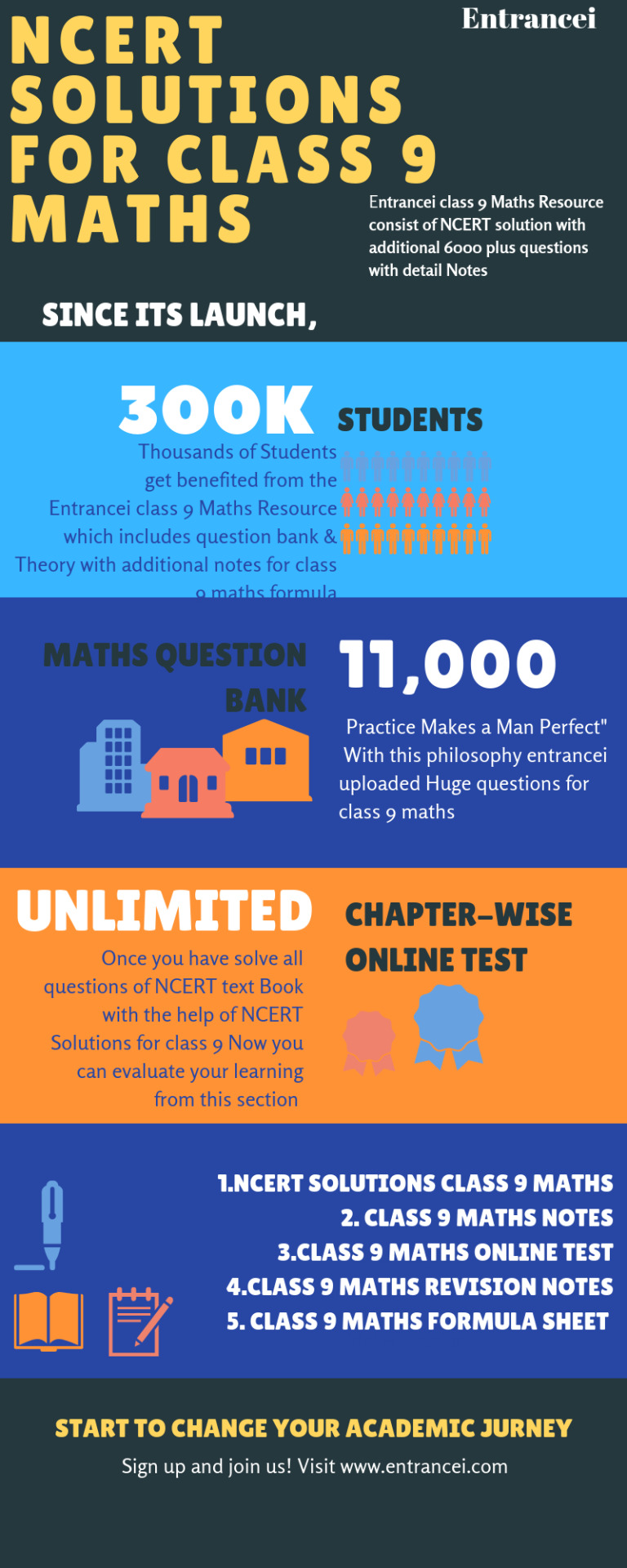
Brace up like scholars
https://www.entrancei.com/topics-topics-class-9-mathematics
The class 9 maths study material is available in PDF format which can be easily downloaded from our site. One can also access a very specific and examination focused strategy for class 9 maths by just simple signup at Entrancei. The sole idea has been to create a most accurate and detailed solution for class 9 maths that is free of cost. The experienced teachers at Entrancei have very extensively revealed the complete class 9 maths content. They have completely made sure all that is provided is important with respect to examinations. The class 9 maths solutions can be easily utilized for scoring good marks as one can reliably practice form them.
While going through the maths subject Maths formula can help you a lot so do read and revise entire maths formula from entrancei.
All the class 9 maths notes prepared as per the guidelines of CBSE Syllabus and guidelines. One can also go through test services for class 9 maths as it will help in gauging out the overall progress. The choosing union the class 9 maths optimum solutions helps in acing the students with the atmosphere of examination.
As general pattern, the class 9 maths should be taken very seriously as it helps in building strong concepts for further boards in 10th. The complete categorization of the syllabus of class 9 maths has been done in chapters, which helps students to easily go through it.
Ø Chapter 1: Number systems
This chapter throws light upon number lines and how effectively they can be used. The class 9 maths solutions provided helps the students regarding laws of integral and rational powers of real numbers.
Ø Chapter 2: Polynomials
The class 9 maths solutions to this unit give a vivid explanation about polynomials and their detailed terminologies. One will be acknowledged with various types of polynomials such as linear, Constant, quadratic and cubic polynomials.
Ø Chapter 3: Coordinate Geometry
This chapters in class 9 maths help the students in understanding the concepts of Cartesian place and coordinates.
Ø Chapter 4: Linear Equations in two Variables
This chapter in class 9 maths helps the students in understanding the equations presented in two variables. Plotting the equations on graph has been explained in a very detailed format in class 9 maths solutions provided.
Ø Chapter 5: Introduction to Euclid’s Geometry
This chapter of class 9 maths throws minor lights upon how Indian history is associated with Geometry followed in the world. One will be explained regarding the geometry through axiom, Postulates, and Theorems of class 9 maths in detailed format.
Ø Chapter 6: Lines and Angles
The chapter as lines and angles is generally asked as theorems and postulates in class 9 maths examinations. The level of difficulty is very minor compared to other units.
Ø Chapter 7: Triangles
In this chapter of class 9 maths, you will study regarding the congruence of triangles and their associating theorems. This chapter of class 9 maths has various properties such as inequalities and properties in triangles.
Ø Chapter 8: Quadrilaterals
This chapter of class 9 maths comprises of only one theorem as proof. Questions asked in this chapter are relatively very easy.
Ø Chapter 9: Areas of Parallelograms and Triangles
One will be brought to the note of areas in geometrical shapes. The examples of the median can be used in various examples of this in class 9 maths of chapter.
Ø Chapter 10: Circles
This chapter of class 9 maths gives brief insights about subtended angle chord, equal chords, Arc of the circle, cyclic quadrilaterals. This detailed solution of theorems based on triangles, Quadrilaterals, and circles are based in this chapter.
Ø Chapter 11: Constructions
This chapter throws light upon bisecting and creating line segments to angles and lines. The student’s class 9 maths would be learning the creation of triangles with different properties and different base angles.
Ø Chapter 12: Heron’s formula
This chapter of class 9 maths comprises of only three exercises. This chapter gives an extension to the application of heron’s formula in polygons and quadrilaterals and triangles.
Ø Chapter 13: Surfaces Areas and Volumes
The students need not be introduced with this topic as they well studied the mensuration in their earlier classes. One would be acknowledged with volumes of cubes, cylinders, spheres, cones, and the hemisphere’s in their class 9 maths syllabus.
Ø Chapter 14: Statistics
The statistics chapter of class 9 maths is like a simple method of collection of data in different aspects. In total, this chapter of class 9 maths helps one to find the measure of central tendency, mean, median and mode of any raw data provided.
Ø Chapter 15: Probability
With only about 1 exercise in class 9 maths, this chapter is very easy. This is based on observation and frequency of day to day examples.
Why choose Entrancei
There might be times when students are stuck with exercises, so there comes the team of Entrancei with an innovative solution to class 9 maths students. The students can any time give a call in order to get their doubts resolved associated with class 9 maths.
0 notes
Text
2019 FURTHER MATHEMATICS EXAM PREP
This is the Exam Prep for your Further Mathematics Examination. We will work through one of the past questions from WAEC as we prepare you for academic excellence in your exam.
Going all the Way with you
We will work through the detailed solution to the Theory Paper of WAEC WASSCE GCE 2018 Exam in a bid to prepare you ahead of your Exams.
As an advocate for academic excellence, what I will like you to do is to first attempt the question on your own. Don't be afraid of making mistakes. You learn by trying, by failing, and then by success. Only check the solution presented here after you have made a judicious attempt on each question.Remember that there is no "singular right way" to go about solving the questions. Just check for consistency in the rules and formulae and guidelines as you work along.
The video link to the solutions are included and if you feel you need further explanations, simply check out the video to enhance your study. But make sure you attempt the question first. For this reason, the blog is broken such that you have to “READ MORE” to see the solution to the question attempted.
Who we are
At Davetuts Academy, we explores the STEM subjects with the aim of preparing students for academic excellence in their O' Level, A'Levels, JAMB UTME, POST-UTME, GED, GCSE and IGCSE exams. We feature comprehensive solution to examination past questions as we explore the basics of the STEM subjects and utilize appropriate soft tools with tips and tricks to prepare students for academic excellence.
Have a look at our welcome video below:
youtube
If by any means you find this exam prep useful, then go ahead and share and subscribe to our YouTube channel, Davetuts Academy as we aim at building academic excellence together!
So here we go with the Exam Prep for Further Mathematics. All the best with the questions!
A Question on Surd
So first, question 1 from WAEC WASSCE 2018 Further Mathematics Exam:

This is a question on surd operations and you just need to follow the correct steps in evaluating multiplication of surds and then finding the conjugate as appropriate.
The solution is shown below and you can watch the accompanying video for better understanding on how to solve such questions.
Watch the video solution by clicking here.

Evaluating the Upper Limit of a Definite Integral
Question 2 below is a question on definite integral. Go ahead and lay your hands on it.

All you have to do to solve this question is to integrate with respect to x, substitute for the upper and lower limit, and subtract the lower limit function from the upper limit function which is an equation in variable t. The catch is that you have to pick the appropriate value for t from the resulting quadratic equation.
The solution is shown below and you can watch the accompanying video for better understanding on how to solve such questions.
Watch the video solution here.
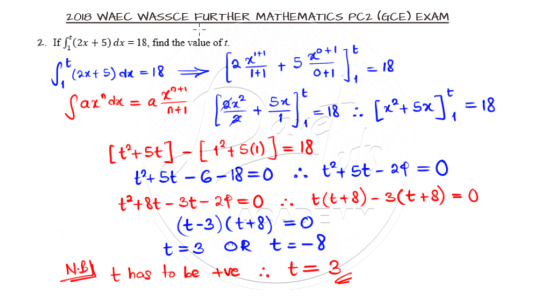
Algebra of Matrices
The next question is on Algebra of matrices. Attempt it first before moving on.

You have to understand the multiplication of matrices to evaluate the square of B and correctly define the identity Matrix I. Once that is done, the matrix N can be evaluated easily.
Click here to watch the video solution to Question 3.
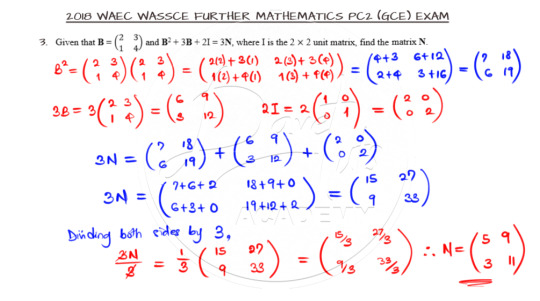
Transform the Equation of a Circle
Question 4 is based on the equation of a circle. Go ahead and try solving on your own first before checking out the solution presented.

Key stuff to simplify the solution include the general equation of a circle and the standard equation of the circle. Furthermore, the process of using completing the square to transform the general equation to the standard equation is quite important to the solution as shown below:


And here is the video for your further study.
youtube
Unordered Selection of Fruits
An unordered selection of fruit is to be carried out in question 5 from combination and you can work it out first.
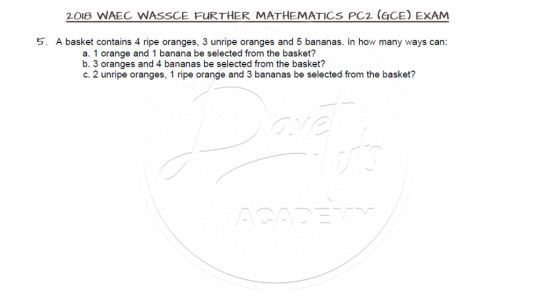
The confusion to avoid here is the matter of ripe and unripe oranges. Once you can sort that out, the combination formula comes in handy to solve the question.
Click here to watch the accompanying video solution.


Estimate Mode using the Graph
Question 6 is asking us to estimate the modal age of a number of workers using graphical method. So bring out the graph paper and let’s get to work.
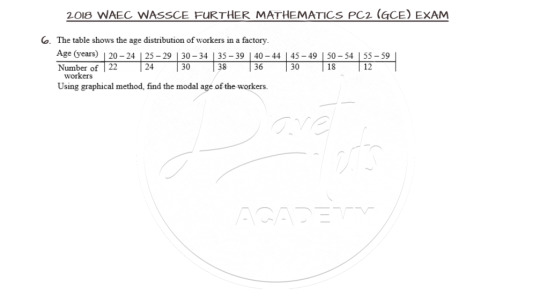
Obviously, you need to know the type of graph that can be used to get the mode of a set of data. And histogram is the go-to diagram to help us out. But first, you have to generate your table of values featuring the class boundary. And then you note the highest bar and cross from the adjoining bars to get the point of intersection which can be traced to get the mode.
If you still have some glitches, click here for the video solution.

Finding an Angle of a Triangle using Vector Method
Vectors is here!!! I so much love vectors. And this question is asking us to use vector method to solve for one of the angles of a triangle. So try it out.
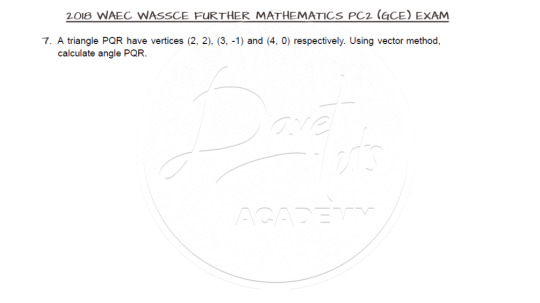
First, locate the vertices of the triangle and then you will observe that the point Q is the point at which the angle is to be evaluated. So, taking vectors PQ and RQ, you can find the dot product from which the angle of inclination of the two vectors can be evaluated to yield the answer.
Watch the video solution by clicking on this line.

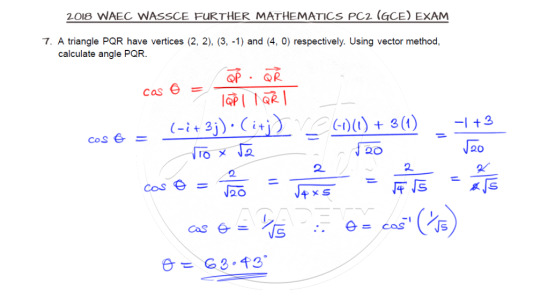
A travelling Motorist in Linear Motion
Next is question 8 based on a travelling motorist. Try it out, please.
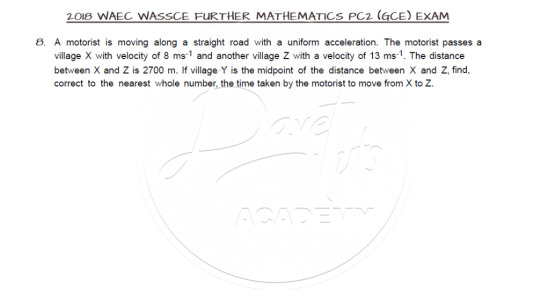
So we need the Linear equations of motion to handle this question. But you have to interpret the question correctly before you can get it right. And there are at least two ways to go about answering this question. One way to solve it is given below.
Click here to watch the video.
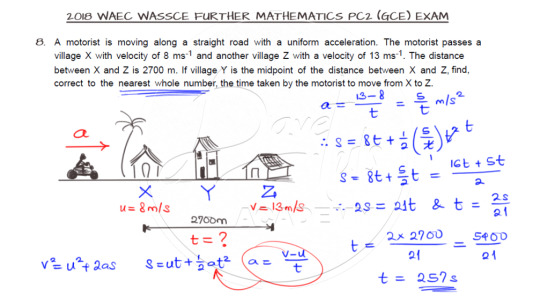
Equation of the Side of a Triangle
Question 9 asks us to evaluate the equation of a line, but not just any line. It is the side of a triangle whose vertices were given. So go ahead and try solving the question.

You need to know that joining the midpoints of two sides of a triangle will yield a line parallel to the third side and since two parallel lines have the same slope, the question can be solved by using the coordinate of the midpoint of the line AB as requested.
Further clarity are presented here in the video solution

Simultaneous Equation + Quadratic Factors
Question 10a is combining a problem on simultaneous equation and factorization of a quadratic polynomial. Try it out and make sure you are on track by making use of your calculator.

To solve this question, you will have to solve a set of simultaneous equations in 3 variables. This will enable you to solve for the values of p, q and r. The resulting quadratic equation can be factored out to get the factors of the given function.
The video solution is presented here.

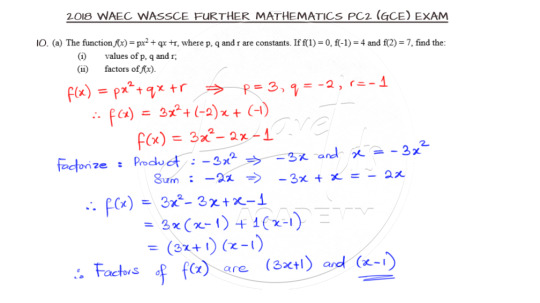
Expressing Rational Function in Partial fractions
Partial fraction is the next question in 10b and the question is as shown below:

The point to note is the splitting of the rational function into its partial fraction components. Once the LCM is sorted out, we can equate the numerators to get the values of the introduced unknowns as shown.
The video solution can be gotten here.


Differentiation from First Principles
Question 11a is on differentiation and we have a simple function to differentiate. But wait a minute. We are to use first principles! So go ahead and attempt this on your own.

I hope you really try this question out. Knowing the technique of differentiation from first principles is vital here. Once the formula is applied, e need to work at eliminating any stand-alone h in the denominator so that we will not have an undefined function while working. For questions like this, the more you practice, the better you become.
Watch the video solution from Davetuts Academy by clicking here.
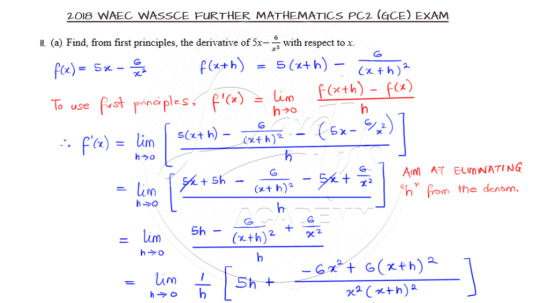
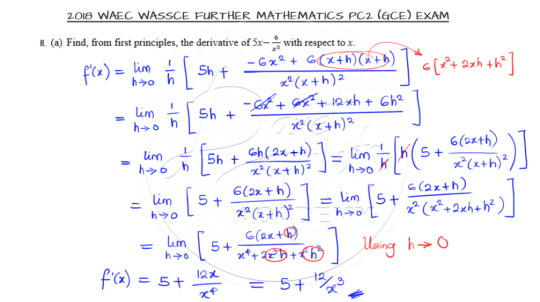
Integration by substitution
Question 11b is based on integration but you need a little trick to solve it. All the best as you attempt this question.

Okay, the little trick is to use substitution. As you can see, trying to integrate straight will constitute the Herculean task of integrating the root of (1-x). So introducing another variable as a function of x and substituting appropriately is the way to go on this type of questions.
And the video is here for better understanding.
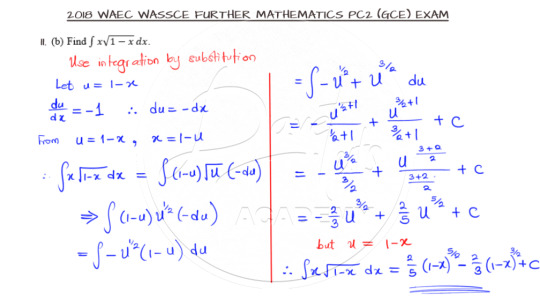
Finding the Spearman’s Rank Correlation Coefficient
Question 12a is on Spearman’s Rank Correlation Coefficient and as expected, go ahead and lay your hands on this question.
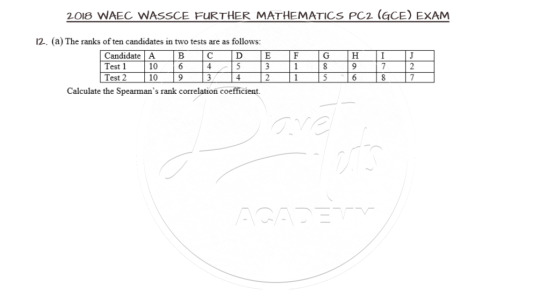
The Spearman's Rank Correlation Coefficient is used to summarize the strength and direction (negative or positive) of a relationship between two variables. For this question, we need to get the square of the difference in the two tests and use that in the formula for the Coefficient as shown below. As a guide, confirm that the sum of the differences equate to zero, otherwise, something is wrong with your calculation.
The video for the solution can be accessed here.

Evaluating Conditional Selection
A conditional selection is to be carried out in Question 12b and you can go ahead to attempt the question.
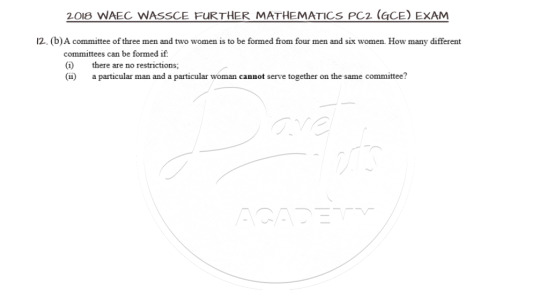
The first case is quite straightforward, but on the second instance, we need to apply our ingenuity to solve for that “harder” case as shown below.
Here is the video solution for the question.
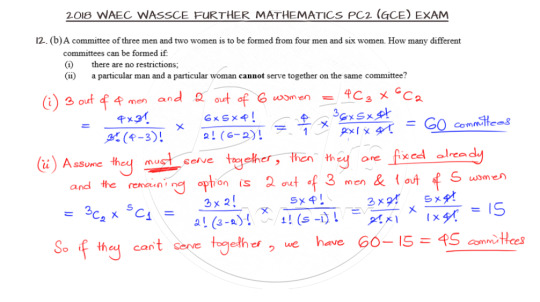
Working with Binomial Probability
Binomial Probability is featured in Question 13 for us to solve as shown.

Binomial probability refers to the probability of exactly x successes on n repeated trials in an experiment which has two possible outcomes. So here our possible outcomes from the selection is picking either a defective bolt or a non-defective bolt. The solution is as shown below:
Check the video tutorial for detailed explanation of the solution to the question.
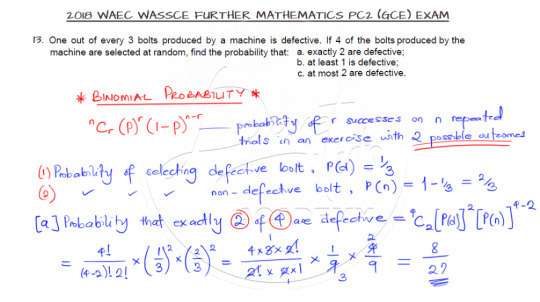


Resolution of Concurrent Co-planar Forces
Question 14 is on the resolution of co-planar forces.

The solution warrants that the inclined forces be resolved to the horizontal and vertical components. This can be done in a variety of ways. You may prefer using the angles 150 and 120 degrees as given or the angles minus 90 degrees or as used in the solution, 180 minus the given angles.

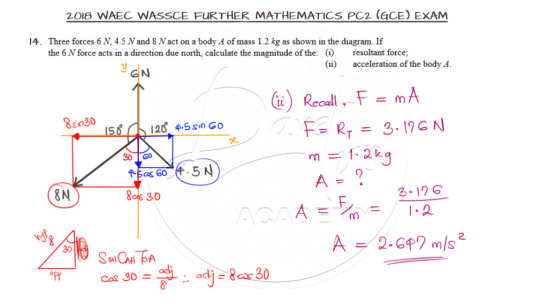
You can watch the video solution as shown below:
youtube
Final Velocity of a Stone under Free Fall
Question 14b features a free falling stone whose final velocity is to be determined.

The equation of motion comes in handy in solving the question as shown below
And here is the link to the video solution too.

Algebra of Vectors
Question 15a features the algebra of vectors. Go through and attempt the question on your own.
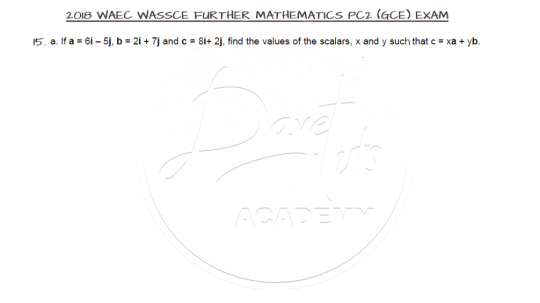
The solution involves opening the brackets and equating the components of the resulting vector equation to get the scalars as requested.
The video solution can be gotten here.
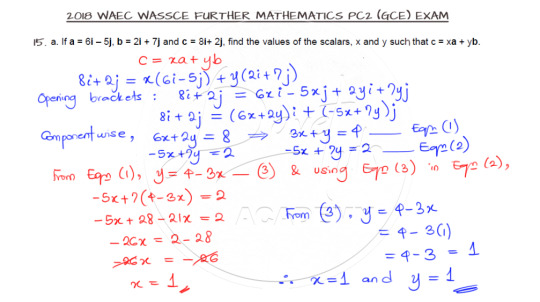
Parallelogram Law of Vectors
Finally, our last question features the parallelogram law of vectors.

The cosine rule comes in handy in solving this question and all you need to note is the requested angle as opposed to the angle used in the cosine rule.
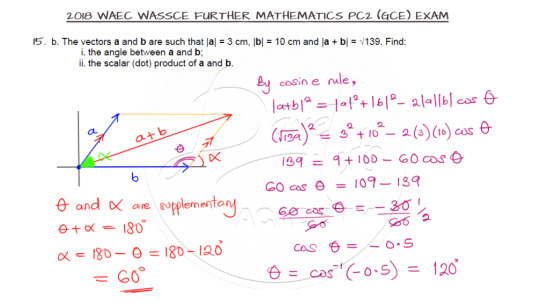
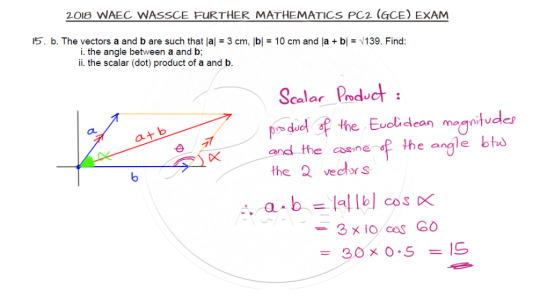
And here is the video solution:
youtube
So that is all about that.
Hopefully, you laid your hands on the questions first before checking with the solution featured here.
Kindly share this and let’s build academic excellence in students together.
Don’t forget to follow #davetutsacademy and visit our YouTube channel for more stuff like this by clicking here: Davetuts Academy.
0 notes
Text
Become A Maths Master With NCERT Solutions

Does your child want to excel in his or her exam? Strengthening the school foundation has become the primary motive of yours? If yes, then the best solution lies with NCERT (National Council of Educational and Research) as your little champ can easily grasp the idea behind the array of questions. The solutions of NCERT give in depth, chapter-wise solutions to the queries of the subject. It also helps students to compare the subject answers with sample answers. Deep learning with polishing the basics of subject materials brings clarity of concept in student minds.
Students find maths, a typical subject during their academy life and to be very honest maximum students says “Maths is quite scary”. To get out from the crux of the marks scoring problem, NCERT solutions for class 8 maths is the best option. The textbook has been designed for the students to give a solid foundation of the subject thoroughly. The most important and difficult subject students find in their 8 exams is maths and scoring highest marks become their main concern. NCERT solutions for class 8 maths cover all chapters step by step detail theory with objective and subjective solved questions.
You can also download NCERT solutions for class 8 maths from the website in just a few clicks. The solutions for maths problems are prepared by professionals which includes the problems from the newest edition of NCERT books and according to CBSE pattern. The brilliant NCERT solutions for class 8 maths give a quick understanding of the subject and assist in solving tough problems too.
Few more tips to excel in your maths exam:
· Make a habit of never missing your maths coaching or classes
· Read the topics before going for the classes
· Use highlighter to mark the important formula
· Studying maths every day not only makes you master for your field but also keeps your concept clear
· First of all, solve all the questions of NCERT and then jump into NCERT solutions for class 8 maths
Apart from this, NCERT solutions for class 8 maths cover the following chapters:
8 Maths Chapter wise Solutions
Chapter 1 - Rational Numbers
Chapter 2 - Linear Equations in One Variable
Chapter 3 - Understanding Quadrilaterals
Chapter 4 - Practical Geometry
Chapter 5 - Data Handling
Chapter 6 - Squares and Square Roots
Chapter 7 - Cubes and Cube Roots
Chapter 8 - Comparing Quantities
Chapter 9 - Algebraic Expressions and Identities
Chapter 10 - Visualising Solid Shapes
Chapter 11 - Mensuration
Chapter 12 - Exponents and Powers
Chapter 13 - Direct and Inverse Proportions
Chapter 14 - Factorisation
Chapter 15 - Introduction to Graphs
Chapter 16 - Playing with Numbers
Math can be a little bit hard for your children, but in case they focus in class and practice the NCERT sums, success is 100 percent. You just keep in mind of not getting so much of rush in solving the question, simply take your time in solving them. Your child must avoid cramming, ask him/her not to stress out, and make sure to ask for rest and eat well before the test. This will keep them energizes and the power to solve the problems increases.
0 notes
Text
CBSE Sample Papers class 8 Maths
About Entrancei CBSE Sample Papers class 8 Maths
In case if you are in search of the best collection of accurate, comprehensive and free PDF with can be read anywhere and anytime, then Entrancei is the place. The expert team of Entrancei have chalked out the most prominent topics of the chapter in CBSE Sample Papers class 8 Maths and placed very precisely. The solution prepared for CBSE Sample Papers class 8 Maths has been reviewed very effectively.
While going through the maths subject Maths formula can help you a lot so do read and revise entire maths formula from entrancei.
Right Approach to use CBSE Sample Papers class 8 Maths
The CBSE Sample Papers class 8 Maths solution provided here will help you to enhance your command over questions in the textbook. One can have their access to the CBSE Sample Papers class 8 Maths questions in a simple process of just signup. The solution to CBSE Sample Papers class 8 Maths is available in a PDF format which could be accessed on mobile and Laptop as well.
The best thing about CBSE Sample Papers class 8 Maths notes is that they have been curated with a very detailed approach. The exercise presented would help you ace over the CBSE Sample Papers class 8 Maths examination. The most prominent thing about CBSE Sample Papers class 8 Maths solution that they are totally free of any cost. They can be a very effective medium of learning the old concepts. These PDF’s can be an effective medium of clearing doubts, which can lead to you losing marks in final examination. All you need to do is just sign up for your free course.
The categorization to the complete CBSE Sample Papers class 8 Maths has been on the basis of fragmenting out the tough and making it simpler. One can go through the detailed categorization made in terms of a chapter.
Chapters covered in CBSE Sample Papers class 8 Maths
Chapter 1: Rational Numbers
This chapter throws light upon properties of real numbers, integers, rational numbers which are crucial with respect to class 8 maths syllabus.
Chapter 2: Linear Equation in one Variable
This chapter of class 8 maths helps in guiding the students in understanding the intrinsic details of solving the linear expression dealing with variable expressions. It is crucial for one to understand the concepts of varied equations in class 8 maths.
Chapter 3: Understanding Quadrilaterals
The students are highlighted regarding the various polygon shapes in class 8 maths before they proceed to the higher levels of mathematics. The theorems and postulates responsible for tetragon and quadrilateral are presented in this chapter.
Chapter 4: Practical Geometry
This chapter of class 8 maths brings a very specific fun engagement among the students as they need to create some very common quadrilaterals and triangles with varied angles.
Chapter 5: Data Handling
This chapter guides the student regarding the methods to check and analyze any data or a case study. The students in class 8 maths would likely be introduced regarding the pie graphs, bar graphs, pictograph, and histogram.
Chapter 6: Squares and Square roots
It helps the class 8 maths students regarding the ways to find sq. roots to various decimal values. It is often utilized in higher categories.
Chapter 7: Cubes and Cube Roots
The procedure to determine the cube roots to various higher values have been explained to class 8 maths students.
Chapter 8: Comparing quantities
This class 8 maths chapter helps in comparing quantitates such as percentage, marked values, discounts, and market values. It throws light upon interest and its types.
Chapter 9: Algebraic Expressions and Identities
This chapter of class 8 maths bring the students close to the expressions and identities utilized in pure mathematics.
Chapter 10: Visualising Solid Shapes
The students are taught in this class 8 maths subject regarding the methods to study varied solid objects such as cylinders, spheres, and hemispheres. One needs to work upon Faces, Vertices, and Edges of different solid geometrical shapes.
Chapter 11: Mensuration
In this chapter of class 8 maths, students will be taught regarding determining the surface areas and perimeters of closed surfaces and open geometrical objects.
Chapter 12: Exponents and Powers
The Exponents and Powers as the name signifies describes regarding the varied number description. It helps the students understanding the documentation decimal numbers I scientific forms. After learning this chapter of class 8 maths one can easily compare large and small numbers in terms of powers.
Chapter 13: Direct and Inverse Proportions
This chapter helps the students regarding the increase and decrease of inverse proportions. The general questions in this chapter of class 8 maths will be quite interesting and based upon daily life.
Chapter14: Factorization
This chapter of class 8 maths throws light upon factorization of natural numbers, algebraic variables, and algebraic numbers.
Chapter 15: Introduction to Graphs
In these students of class 8 maths will be introduced with the plotting and data collection through the graph.
Chapter 16: Playing with Numbers
This chapter of class 8 maths is more of a fun chapter where students will be dealing with various puzzles and games.
Why choose Entrancei for CBSE Sample Papers class 8 Maths
Since students in CBSE Sample Papers class 8 Maths are just in their schools. They need to be well focused and have clear concepts regarding various analogies of CBSE Sample Papers class 8 Maths. The educators and experts at Entrancei have prepared very extensive study material keeping in mind the requirement of examinations. Solve all questions given in Important Questions for class 8 Maths prepared by Entrancei experts.
SOURCE:- https://entranceincert.blogspot.com/2020/09/cbse-sample-papers-class-8-maths.html
0 notes
Text
Class-8 Mathematics NCERT Soluction Ex-2.5 chapter-2 #Mathswithnarendrasir #Narendrasir
#linear equations in one variable class 8 in hindi#linear equations in one variable class 8 ex 2.1#linear equations in one variable class 8 in english#linear equations in one variable class 8 activity#linear equations in one variable class 8 answers#linear equations in one variable class 8 all formulas#linear equations in one variable class 8 cbse#linear equations in one variable class 8 chapter 2#linear equations in one variable class 8 dav#linear equations in one variable class 8 full chapter#linear equations in one variable class 8 formulas#linear equations in one variable for class 8#linear equations in one variable class 8 hindi#linear equations in one variable class 8 hindi medium#linear equations in one variable class 8 important questions#Math's with Narendra Sir provide to you maths videos for all classes.#Maths with Narendra Sir give you live-class platform#for math skills.#Learn math by taking free online math courses.#Get introductions to algebra#geometry#trigonometry with current math coursework and AP exam preparation.#Select a course to learn more.#We create a unique adaptive learning path for you#We diagnose and identify the student’s current needs#basic mathema#tics#basic mathematics topics#list of basic mathematics topics#basic mathematics topics for primary school
0 notes
Text
MATH REVIEW NOTES FOR CLASS 10
Mathematics is one of the most important subjects in student life. It is not a topic to read or just listen to, it needs to be revised to remember all of the concepts, and a review grade is very important for grade 10 because grades are just a word, but they are make up each point for that. Studies that become very useful during the exam period. Incoming teachers with academic experience created Grade 10 review notes explaining key concepts, theorems and formulas. Class 10 has a very important class in our careers and mathematics is one of the main subjects that will play an important role in our future. The excellent mastery of Grade 10 mathematics helps students advance their careers to a great extent.
CLASS 10 MATH REVIEW CHAPTER
1. Real numbers
2. Polynomials
3. Pair of linear equations with two variables.
4. Quadratic equations
5. arithmetic progression
6. Coordinated geometry
7. Triangles
8. Trigonometry
9. Applications of trigonometry.
Tenth circles
11. Constructions
12. Area linked to circles.
13. Measure
14. Statistics
15. Probability
WHY IS ENTRY IMPORTANT FOR CLASS 10 REVIEW NOTES?
The appearance of class 10 creates pressure among the students. The Entrancei Academy team develops class 10 mathematical solutions. Our Entrancei university teachers have prepared a NCERT solution of class 10 math which answers all the questions in the NCERT manual in accordance with the CBSE guidelines for board reviews. Solving step by step The pupils have problems, then they come to our department for questions and then our teachers come directly to solve their difficulties. In addition to all of these preparations, expert teachers have prepared math resources, including NCERT solutions, RD Sharma class 10 math solutions and weekly exams, etc. which is very useful for the exam.
HOW IS THE CLASS 10 MATH TEST EFFECTIVE?
Solving math questions regularly can improve your addition skills on a daily basis. Always remember that math is not about reading and listening. You must solve math questions daily to improve your ability to solve questions. Many students are often stuck in difficult numbers, so our academic teachers will help you with these difficulties. Students can follow the Grade 10 NCERT revision notes for math solutions created by our teachers. The complete NCERT solutions for class 10 was made available free of charge.
Source Url: https://bit.ly/3eJH8Rc
0 notes
Text
How to Score Good Marks in Class 7 with the Help of RS Aggarwal Solutions
This page is prepared by renowned faculty of maths who are part of Entrancei academic team. From this page, you can download any exercise or questions from RS Aggarwal class 7 maths book.
If you want to score good marks in class 7 maths you required good practice of numerical with the concept clarity. RS Aggarwal Class 7 solutions maths book is full of questions and the theory is explained very nicely with solved examples.
Read the theory of RS Aggarwal textbook and start solving the exercise. Follow NCERT textbook for theory or your school class notes and then start solving RS Aggarwal class 7 solutions maths book while solving questions from exercise if you face any problem you can take help from RS Aggarwal solutions class 7 maths book prepared by expert faculty members of Entrancei.
Chapter-1 Integers
Chapter-2 Fractions
Chapter-3 Decimals
Chapter-4 Rational Numbers
Chapter-5 Exponents
Chapter-6 Algebraic Expressions
Chapter-7 Linear Equations in One Variable
Chapter-8 Ratio and Proportion
Chapter-9 Unitary method
Chapter-10 Percentage
Chapter-11 Profit and Loss
Chapter-12 Simple Interest
Chapter-13 Lines and Angles
Chapter-14 Properties of Parallel Lines
Chapter-15 Properties of Triangles
Chapter-16 Congruence Chapter-17 Constructions
Chapter-18 Reflection and Rotational Symmetry
Chapter-19 Three-Dimensional Shapes
Chapter-20 Mensuration
Chapter-22 Bar Graphs
Chapter-21 Collection and Organisation of Data
Also Read: How to Study RS Aggarwal Class 8 Solutions Effectively?
How to score good marks in class 7 with the help of RS Aggarwal solutions
Class 7 maths start with the revision of maths what you have read in class 6. You will learn a few new concepts like integers application of integers and few new concepts of geometry as of now the syllabus is not vast nor it is difficult. This is a very crucial class for your upcoming maths chapter and upcoming maths as a subject.
From class 7, students develop an interest in maths. So be serious and plan accordingly. While solving class 7 maths RS Aggarwal maths book will give you an additional edge over the NCERT textbook. RS Aggarwal maths book consists of questions and the best part is the level of difficulty.
In RS Aggarwal class 7 solutions maths book increasing slowly to give a higher level of understanding to the topic and boost your confidence. One must try each and every question given in RS Aggarwal Book by yourself and if there is any question which you unable to solve try 4 to 5 times before referring to RS Aggarwal solutions class 7.
Academic team of Entrancei prepared RS Aggarwal solutions class 7 for your reference. Our team prepared solution of all question in the textbook of RS Aggarwal maths which will help you to have a better understanding of chapter and questions. Always remember that maths is a subject of practice and RS Aggarwal class 7 maths book consist of almost 200 questions in each chapter which is sufficient to have confidence in that chapter.
After that, you can give chapter wise online test of the chapter from Entrancei to have more clarity on the chapter. We have uploaded thousands of questions for class 7 maths and science do check it out. Never try to memorise RS Aggarwal solutions class 7 it will decrease your thinking ability.
While reading the theory from RS Aggarwal class 7 maths book or NCERT always try to write down the most important formula in your notebook this habit will pay you in final revision as well as help you to retain the formula for a long time. These formulas you are going to use in almost all the higher class. So guys all the very best for your preparation.
Academic team of Entrancei prepared different type of resource for class 7 Maths which includes detail theory, notes, revision notes, question bank for class 7 maths, NCERT solutions for class 7 maths, RS Agarwal solutions for class 7 maths & Maths formula.
Do your revision with Entrancei resource and practice. Solve questions from all chapter of class 7 maths from Entrancei resources all resource are available freely to students don’t forget to share our resource with your friends.
The following flow chat is added to explain the best strategies to enhance your potential in class 7 maths syllabus and boost your confidence with an increased level of interest in class 7 maths.
Source URL: https://www.entrancei.com/rs-aggarwal-class-7-solutions
0 notes
Link
Free education is the right of every student. Ashish Kumar – Let’s Learn is providing deep and detailed explanations of full syllabus, all important questions, all important examples and all NCERT solutions for Class 11 Maths through videos on YouTube Channel as well as Blogs and PDFs on website.
Students can learn through videos and blogs and can ask their doubts on Website’s Discussion panel or on YouTube’s Comments Page. Students will also be provided notes, assignments, books and various other educational resources in electronic forms like PDFs, Docs, mp4 etc., which will help them to prepare for CBSE Class 12 Board Exams but more importantly for their upcoming life’s adventures.
You can easily access all chapters with NCERT Solutions for class 11 maths on this page: https://www.ashishkumarletslearn.com/cbse/class-11/maths/
Following are summaries of chapter wise syllabus recommended by CBSE for Class 11 mathematics students with their YouTube as well as Website links.
Unit-I: Sets and Functions
1. Sets:
Sets and their representations. Empty set. Finite and Infinite sets. Equal sets. Subsets. Subsets of a set of real numbers especially intervals (with notations). Power set. Universal set. Venn diagrams. Union and Intersection of sets. Difference of sets. Complement of a set. Properties of Complement.
2. Relations & Functions:
Ordered pairs. Cartesian product of sets. Number of elements in the Cartesian product of two finite sets. Cartesian product of the set of reals with itself (upto R x R x R). Definition of relation, pictorial diagrams, domain, co-domain and range of a relation. Function as a special type of relation. Pictorial representation of a function, domain, co-domain and range of a function. Real valued functions, domain and range of these functions, constant, identity, polynomial, rational, modulus, signum, exponential, logarithmic and greatest integer functions, with their graphs. Sum, difference, product and quotients of functions.
3. Trigonometric Functions:
Positive and negative angles. Measuring angles in radians and in degrees and conversion from one measure to another. Definition of trigonometric functions with the help of unit circle. Truth of the identity sin2x+cos2x=1, for all x. Signs of trigonometric functions. Domain and range of trigonometric functions and their graphs. Expressing sin (x±y) and cos (x±y) in terms of sinx, siny, cosx & cosy and their simple applications. Deducing identities. Identities related to sin2x, cos2x, tan2x, sin3x, cos3x and tan3x. General solution of trigonometric equations of the type siny = sina, cosy = cosa and tany = tana.
Unit-II: Algebra
4. Principle of Mathematical Induction:
Process of the proof by induction, motivating the application of the method by looking at natural numbers as the least inductive subset of real numbers. The principle of mathematical induction and simple applications.
5. Complex Numbers and Quadratic Equations:
Need for complex numbers, especially √ , to be motivated by inability to solve some of the quadratic equations. Algebraic properties of complex numbers. Argand plane and polar representation of complex numbers. Statement of Fundamental Theorem of Algebra, solution of quadratic equations (with real coefficients) in the complex number system. Square root of a complex number.
6. Linear Inequalities:
Linear inequalities. Algebraic solutions of linear inequalities in one variable and their representation on the number line. Graphical solution of linear inequalities in two variables. Graphical method of finding a solution of system of linear inequalities in two variables.
7. Permutations and Combinations:
Fundamental principle of counting. Factorial n. (n!) Permutations and combinations, derivation of formulae for and and their connections, simple applications.
8. Binomial Theorem:
History, statement and proof of the binomial theorem for positive integral indices. Pascal’s triangle, General and middle term in binomial expansion, simple applications.
9. Sequence and Series:
Sequence and Series. Arithmetic Progression (A. P.). Arithmetic Mean (A.M.) Geometric Progression (G.P.), general term of a G.P., sum of n terms of a G.P., infinite G.P. and its sum, geometric mean (G.M.), relation between A.M. and G.M. Formulae for the following special sums.
Unit-III: Coordinate Geometry
10. Straight Lines:
Brief recall of two dimensional geometry from earlier classes. Shifting of origin. Slope of a line and angle between two lines. Various forms of equations of a line: parallel to axis, point -slope form, slope intercept form, two-point form, intercept form and normal form. General equation of a line. Equation of family of lines passing through the point of intersection of two lines. Distance of a point from a line.
Unit-IV: Calculus
13. Limits and Derivatives:
Derivative introduced as rate of change both as that of distance function and geometrically. Intuitive idea of limit. Limits of polynomials and rational functions trigonometric, exponential and logarithmic functions. Definition of derivative relate it to scope of tangent of the curve, derivative of sum, difference, product and quotient of functions. Derivatives of polynomial and trigonometric functions.
#ncert solutions for class 11 maths#ncert solutions#class 11 maths#sequences and series#limits and derivatives#Calculus#class 11 maths ncert solutions chapter 10#class 11 maths straight lines#straight lines#binomial theorem#permutation and combination#linear inequalities#ashish kumar lets learn#ashish kumar
0 notes
Text
MAT 116 Complete Course Material
Follow Below Link to Buy Answer or Oder Us for 100% Original and Plagiarism Free Work
Email us for original work at ( [email protected] )
http://homeworkeducation.com/downloads/mat-116-complete-course-material/
MAT 116 Week 1-9 Complete Course
MAT 116 Week 1 Discussion Question 1
What is the difference between an equation and an expression? Include an example of each. Can you solve for a variable in an expression? Explain your answer. Can you solve for a variable in an equation? Explain your answer. Write a mathematical phrase or sentence for your classmates to translate.
Mat 116 Week one DQ 1
What are the steps of the order of operations? Why is it important that you follow the steps rather than solve the problem from left to right? Write an expression for your classmates to simplify using at least three of the following: o Groupings: Parenthesis, brackets, or braces o Exponents o Multiplication or division o Addition or subtraction Consider participating in the discussion by simplifying a classmate’s expression, showing how the expression would be incorrectly simplified if computed from left to right, or challenging the class with a complicated expression. Respond to your initial post and provide your classmates with the answer to your expression.
Mat 116 Week one DQ 2
When simplifying expressions, what are some common mathematical operations many students find difficult? Please illustrate by providing an example.
MAT 116 Discussion Question 2
Explain a real-world problem that you used math to solve. What mathematical expressions did you use in your problem solving? Define your variables and explain your expression.
MAT 116 Discussion Question 4
Why is it important to follow the order of operations? What are some possible outcomes when the order of operations is ignored? If you invented a new notation where the order of operations was made clear, what would you do to make it clear?
MAT 116 Week 1 Discussion Question 5
Why is it important that you follow the steps rather than solve the problem from left to right? Write an expression (numbers only) for your classmates to simplify using at least three of the following: Groupings (parenthesis, brackets, or braces)·
Exponents· Multiplication or division· Addition or subtraction·
MAT 116 Discussion Question 7
What resources are available to help you do well in this course? Which resources do you think will help you the most? Why? How do you plan to use the resources available to optimize your learning over the next 8 weeks?
MAT 116 Discussion Question 8
What are the four steps for solving an equation? Should any other factors be accounted for when solving an equation? Should any factors be accounted for when explaining how to solve an equation? Explain your answer.
MAT 116 Discussion Question 10
Post an equation or inequality from your week 2 readings. Using the four step process of solving equations, explain how you would solve the equation.
Then post an equation or inequality for the class to practice.
MAT 116 Discussion Question 13
How do you know if a value is a solution for an inequality? How is this different from determining if a value is a solution to an equation?
If you replace the equal sign of an equation with an inequality sign, is there ever a time when the same value will be a solution to both the equation and the inequality?
Write an inequality and provide a value that may or may not be a solution to the inequality.
MAT 116 Discussion Question 14
What are the four steps for solving a problem? Should any other factors be accounted for when solving a problem? Should any factors be accounted for when explaining how to solve a problem?
MAT 116 Discussion Question 15
What is the difference between a scatter plot and a line graph? What type of information would be better represented in a line graph?
MAT 116 Discussion Question 16
If a line has no y-intercept, what can you say about the slope and graph of that line? What if a line has no x-intercept? What would be the slope of that line, what would the graph look like? How would you graph the line y = -1/2x + 2?
MAT 116 Discussion Question 17
Address the following:
What similarities and differences do you see between functions and linear equations studied in Ch. 3?
Are all linear equations functions? Is there an instance when a linear equation is not a function? Support your answer.
Create an equation of a nonlinear function and provide two inputs for your classmates to evaluate.
MAT 116 Discussion Question 18
What is the difference between domain and range? Describe a real-life situation that could be modeled by a function.
Describe the values for x that may not be appropriate values even when they are defined by your classmates’ function.
MAT 116 Discussion Question 19
Systems of equations can be solved by graphing or by using substitution or elimination. What are the pros and cons of each method? Which method do you like best? Why? What circumstances would cause you to use a different method?
MAT 116 Discussion Question 20
Post your response to all of the following:
Review examples 2, 3, and 4 in section 8.4 of the text.
How does the author determine what the first equation should be?
What about the second equation?
How are these examples similar? How are they different?
Find a problem in the text that is similar to examples 2, 3, and 4
MAT 116 Discussion Question 21
What is the difference between an equation and an expression? Include an example of each. Can you solve for a variable in an expression? Explain your answer. Can you solve for a variable in an equation? Explain your answer. Write a mathematical phrase or sentence for your classmates to translate.
MAT 116 Discussion Question 22
Why is it important that you follow the steps rather than solve the problem from left to right? Write an expression (numbers only) for your classmates to simplify using at least three of the following:
Groupings: (parenthesis, brackets, or braces)
Exponents
Multiplication or division
Addition or subtraction
MAT 116 Discussion Question 23
Why does the inequality sign change when both sides are multiplied or divided by a negative number? Does this happen with equations? Why or Why not?
Write an inequality for your classmates to solve. In your inequality, use both the multiplication and addition properties of inequalities.
MAT 116 Discussion Question 24
How do you know if a value is a solution for an inequality? How is this different from determining if a value is a solution to an equation?
If you replace the equal sign of an equation with an inequality sign, is there ever a time when the same value will be a solution to both the equation and the inequality?
Write an inequality and provide a value that may or may not be a solution to the inequality.
MAT 116 Week 2 Appendix C Quiz
MAT 116 Week 2 Assignment Expressions and Equations Appendix C
MAT 116 Week 4 Assignment Solving and Graphing Equations Appendix D
MAT 116 Week 5 Discussion Question 1
Imagine that a line on a graph is approximately the distance y in feet a person walks in x hours. What does the slope of this line represent? How is this graph useful? Provide another example for your colleagues to explain.
MAT 116 Week 5 Discussion Question 1
Address the following:
What similarities and differences do you see between functions and linear equations studied in Ch. 3?
Are all linear equations functions? Is there an instance when a linear equation is not a function? Support your answer.
Create an equation of a nonlinear function and provide two inputs for your classmates to evaluate.
MAT 116 Week 5 Discussion Question 2
What are the differences among expressions, equations, and functions? Provide examples of each.
MAT 116 Week 5 Discussion Question 2
What is the difference between domain and range? Describe a real-life situation that could be modeled by a function.
MAT 116 Week 6 Assignment Functions and Their Graphs Appendix E
MAT 116 Week 6 DQ 1
Find a word problem that could be solved using systems of equations from your readings. Post the problem and explain how the equations would be written for that problem. Make sure to establish the variables and explain each equation. For practice during the discussion you may solve other classmates problems.
An airplane flies 1200 miles into the wind in 3 hours. The return trip takes 2 hours. Find the speed of the airplane without a wind and the speed of the wind.
MAT 116 Week 6 DQ 2 What are two symbolic techniques used to solve linear equations? Which do you feel is better? Explain why.
Post an example for your class to solve.
MAT 116 Week 7 DQ 1
How many solution sets do systems of linear inequalities have? Do solutions to systems of linear inequalities need to satisfy both inequalities? In what case might they not?
MAT 116 Week 7 DQ 2
Do the equations x = 4y + 1 and x = 4y – 1 have the same solution? How might you explain your answer to someone who has not learned algebra?
MAT 116 Week 8 Assignment Systems of Equations and Inequalities Appendix F
Week 9 DQ 1
Provide one real-world example of when graphing could be useful. Do you think you would ever use graphing in your life to solve problems? Explain why or why not.
Week 9 DQ 2
What concept learned in this course was the easiest for you to grasp? Why do you think it was easy for you? Which was the hardest? What would have made it easier to learn?
0 notes